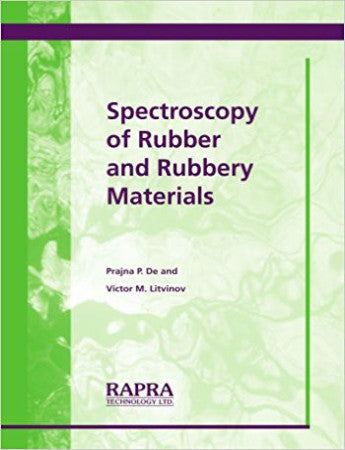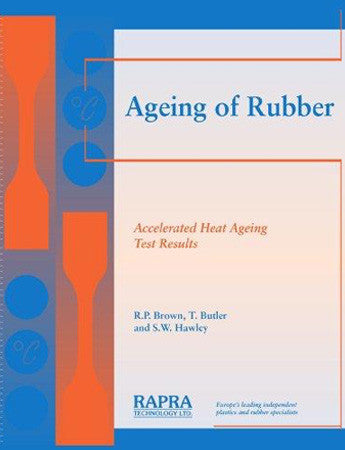Spectroscopy of Rubber and Rubbery Materials
This book deals with the application of spectroscopic techniques for characterisation of chemical and physical structures in viscoelastic materials, such as unvulcanised elastomers and their vulcanisates, various rubbery materials and some plastics, which when blended with particular additives (plasticisers) behave like rubbers.
Analysis of the rubbery materials is complicated by the fact that rubbery products, such as tyres, tubes, seals, V-belts, and hoses, contain in the rubbery matrix a significant amount of various compounds, i.e., fillers, vulcanising agents, antioxidants, and plasticisers. Due to the complex composition, no single technique can provide a good understanding of the effect of chemical and physical structures on the functional properties of rubbery materials. Thus spectroscopy has become a powerful tool for the determination of polymer structures.
The most comprehensive information on chemical and physical structures in relation to material properties can be obtained by using a combination of macroscopic techniques and methods that provide information on the molecular level.
The major part of the book is devoted to techniques that are the most frequently used for analysis of rubbery materials, i.e., various methods of nuclear magnetic resonance (NMR) and optical spectroscopy. The main objective of this present book is to discuss a wide range of applications of the spectroscopic techniques for the analysis of rubbery materials.
The book brings together the various spectroscopic techniques for obtaining the following information: chemical structure of rubbery materials, network structure analysis, heterogeneity of rubbery materials, physical properties of rubbery materials, functional properties and stability of rubbery materials, processing of rubbery materials and quality control.
The contents of this book are of interest to chemists, physicists, material scientists and technologists who seek a better understanding of rubbery materials.
Analysis of the rubbery materials is complicated by the fact that rubbery products, such as tyres, tubes, seals, V-belts, and hoses, contain in the rubbery matrix a significant amount of various compounds, i.e., fillers, vulcanising agents, antioxidants, and plasticisers. Due to the complex composition, no single technique can provide a good understanding of the effect of chemical and physical structures on the functional properties of rubbery materials. Thus spectroscopy has become a powerful tool for the determination of polymer structures.
The most comprehensive information on chemical and physical structures in relation to material properties can be obtained by using a combination of macroscopic techniques and methods that provide information on the molecular level.
The major part of the book is devoted to techniques that are the most frequently used for analysis of rubbery materials, i.e., various methods of nuclear magnetic resonance (NMR) and optical spectroscopy. The main objective of this present book is to discuss a wide range of applications of the spectroscopic techniques for the analysis of rubbery materials.
The book brings together the various spectroscopic techniques for obtaining the following information: chemical structure of rubbery materials, network structure analysis, heterogeneity of rubbery materials, physical properties of rubbery materials, functional properties and stability of rubbery materials, processing of rubbery materials and quality control.
The contents of this book are of interest to chemists, physicists, material scientists and technologists who seek a better understanding of rubbery materials.
Chapter Titles
1. Characterisation of Elastomers Using (Multi) Hyphenated Thermogravimetric Analysis Techniques
2. Photoacoustic Fourier Transform Infrared Spectroscopy of Rubbers and Related Materials
3. Infrared Spectroscopy of Rubbers
4. Application of Infrared Spectroscopy to Characterise Chemically Modified Rubbers and Rubbery Materials
5. Infrared Spectroscopy of Rubbery Materials
6. Crosslinking of EPDM and Polydiene Rubbers Studied by Optical Spectroscopy
7. NMR Imaging of Elastomers
8. NMR in Soft Polymeric Matter: Nanometer-Scale Probe
9. Chemical Characterisation of Vulcanisates by High-Resolution Solid-State NMR
10. Characterisation of Chemical and Physical Networks in Rubbery Materials Using Proton NMR Magnetisation Relaxation
11. High-Resolution NMR of Elastomers
12. 129Xe NMR of Elastomers in Blends and Composites
13. Swollen Rubbery Materials: Chemistry and Physical Properties Studied by NMR Techniques
14. Multidimensional NMR Techniques for the Characterisation of Viscoelastic Materials
15. Deuterium NMR in Rubbery Materials
1. Characterisation of Elastomers Using (Multi) Hyphenated Thermogravimetric Analysis Techniques
2. Photoacoustic Fourier Transform Infrared Spectroscopy of Rubbers and Related Materials
3. Infrared Spectroscopy of Rubbers
4. Application of Infrared Spectroscopy to Characterise Chemically Modified Rubbers and Rubbery Materials
5. Infrared Spectroscopy of Rubbery Materials
6. Crosslinking of EPDM and Polydiene Rubbers Studied by Optical Spectroscopy
7. NMR Imaging of Elastomers
8. NMR in Soft Polymeric Matter: Nanometer-Scale Probe
9. Chemical Characterisation of Vulcanisates by High-Resolution Solid-State NMR
10. Characterisation of Chemical and Physical Networks in Rubbery Materials Using Proton NMR Magnetisation Relaxation
11. High-Resolution NMR of Elastomers
12. 129Xe NMR of Elastomers in Blends and Composites
13. Swollen Rubbery Materials: Chemistry and Physical Properties Studied by NMR Techniques
14. Multidimensional NMR Techniques for the Characterisation of Viscoelastic Materials
15. Deuterium NMR in Rubbery Materials
Victor M. Litvinov is a senior researcher at the Department of Molecular Identification and Quantification at DSM Research, Campus Geleen, The Netherlands. He is responsible for the characterisation of chemical and physical structures in organic and inorganic materials by solid-state NMR techniques, applications of the method for quality control and establishing structure-property relationships. After graduating in 1973 from the Moscow Academy for Fine Chemical Technology, he worked in the Scientific Council on High-Performance Polymer Materials at the Presidium Academy of Sciences in Moscow, Russia. In 1978, he received a Ph.D. in macromolecular chemistry. From 1985 until 1992, he worked at the Institute of Synthetic Polymer Material of Academy of Sciences, Russia. In 1992, he joined DSM Research.
Prajnaparamita De is a Professor in the Rubber Technology center at the Indian Institute of Technology, Kharagpur, India. She has been working in the characterisation of polymers and rubbers for last 20 years, especially in the field of infrared spectroscopic studies.She has also worked on thermoplastic elastomers, adhesion, blends, polymer-filler bonding, utilisation of waste polymers and rubbers. Prajna has published about 130 research papers in international journals and delivered lectures in various universities, companies and at conferences in several countries.
Prajnaparamita De is a Professor in the Rubber Technology center at the Indian Institute of Technology, Kharagpur, India. She has been working in the characterisation of polymers and rubbers for last 20 years, especially in the field of infrared spectroscopic studies.She has also worked on thermoplastic elastomers, adhesion, blends, polymer-filler bonding, utilisation of waste polymers and rubbers. Prajna has published about 130 research papers in international journals and delivered lectures in various universities, companies and at conferences in several countries.




